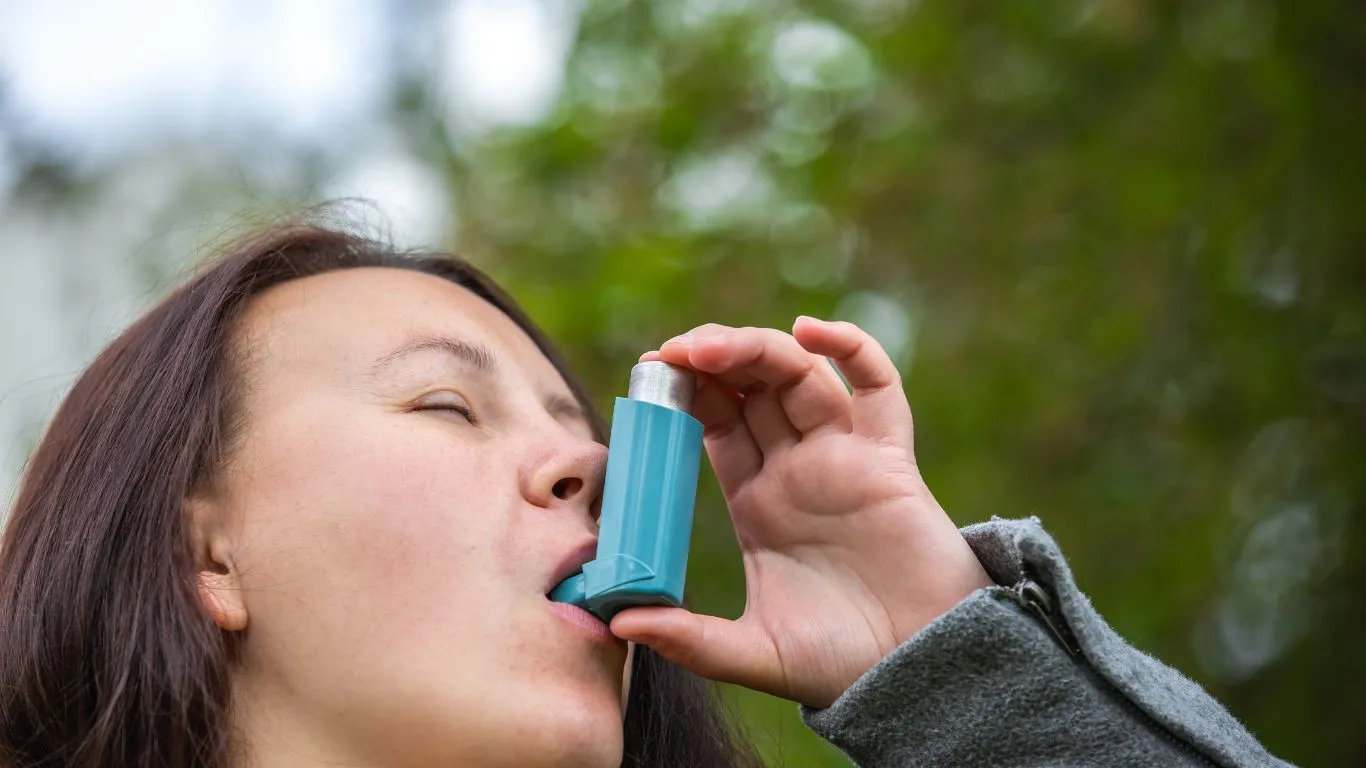Can Asthma Cause Sore Muscles? Discover the Surprising Link Today!
Can asthma cause sore muscles? You’d be surprised how often that question comes up, especially from patients who’ve been struggling with a flare-up or those newly diagnosed and confused by all the unexpected symptoms. As a Pulmonary Nurse, I’ve heard this more times than I can count—and let me tell you, it’s not a silly question at all. Actually, it’s a really smart one. Muscular pain, especially around the chest, back, and even the neck, can absolutely be related to asthma. It’s just not something most people talk about, and unfortunately, many doctors don’t always explain the connection clearly. So, let’s break this down together in a real-world, no-jargon kind of way.
What Happens to Your Body During an Asthma Attack?

Okay, let’s get into what’s actually happening when someone has an asthma attack. During an episode, your airways narrow, swell up, and start producing extra mucus. Sounds fun, right? Not exactly. This makes breathing really hard and forces your body to compensate in all sorts of ways—ways that often involve your muscles working overtime.
When you’re gasping for air, your respiratory muscles—especially the intercostals (the little muscles between your ribs), neck, and even shoulder muscles—kick into high gear. It’s like asking your body to sprint without moving your legs. That constant, repetitive overuse of these muscles can leave them sore, tight, and tender, even hours or days later. So yes, asthma can absolutely lead to sore muscles.
Let’s Talk About Those Sore Muscles

Where Does the Pain Usually Show Up?
Based on what I’ve seen over the years and what patients share, sore muscles due to asthma tend to pop up in a few key spots:
- Chest muscles – These work the hardest to help expand and contract your lungs.
- Upper back and shoulders – Especially if you’re tensing up during an attack.
- Neck muscles – Often strained when people struggle to draw in more air.
One patient of mine described it like they had just done an intense workout—only they hadn’t been to the gym. They had just been trying to breathe.
Why This Happens (In Plain English)
Think of it this way: Your lungs are the star of the show during asthma episodes, but your muscles are the crew backstage making the magic happen. The more the lungs struggle, the harder the crew works. That overuse leads to microscopic tears and tension—the same thing that causes muscle soreness after exercise.
What’s more, when you’re not getting enough oxygen during an attack, your body goes into stress mode. That fight-or-flight response pumps out cortisol and adrenaline, which might help in the short term but can leave your muscles tight and achy afterward. Trust me, I’ve helped folks through enough middle-of-the-night ER visits to know this pattern all too well.
Can Asthma Cause Sore Muscles Over Time?

Chronic Discomfort Is a Thing
If your asthma isn’t well controlled, it’s not just the occasional soreness you’re dealing with. Chronic muscle tightness can creep in slowly, especially in people who breathe shallowly or use accessory muscles all the time. You may not even notice at first—just a little stiffness here, a bit of discomfort there—until one day you’re realizing you haven’t taken a deep breath without pain in months.
Other Contributing Factors
Sometimes, sore muscles in asthma aren’t just about the breathing struggle. Here are a few more culprits that could be making it worse:
- Poor posture: People with breathing problems often hunch forward to ease airflow. That wrecks your neck and upper back muscles over time.
- Overuse of inhalers: Some fast-acting inhalers, like albuterol, can cause muscle tremors or twitching, which can feel like soreness after prolonged use.
- Anxiety: Asthma and anxiety go hand-in-hand more often than you’d think. Anxiety leads to tension, which leads to—you guessed it—sore muscles.
I had a patient, let’s call her Jamie, who came in complaining about chest pain that her EKG said wasn’t cardiac-related. Turns out, it was muscle soreness from shallow breathing during anxiety-induced asthma episodes. Once we got her treatment plan adjusted and added in some breathing therapy, she felt so much better.
When You Should Be Concerned
While sore muscles from asthma are pretty common, there are some red flags you shouldn’t ignore. If the pain is sharp, one-sided, or doesn’t improve with rest, it’s time to dig deeper. Also, if you’re experiencing muscle pain along with tingling or numbness, that might suggest nerve involvement or something else entirely.
As always, don’t guess—get checked out. Muscle soreness might seem minor, but in some cases, it’s a signal that your asthma needs better control or that there’s another issue hiding underneath.
How to Manage Muscle Pain While Dealing with Asthma

If you’re dealing with sore muscles due to asthma, you’re probably wondering how you can get some relief without letting your asthma take a back seat. The good news is that you can take steps to ease muscle discomfort while managing your asthma at the same time. As a Pulmonary Nurse, I’ve worked with many patients on creating personalized action plans that address both concerns simultaneously.
Breathing Techniques to Ease the Tension
First things first—if you have asthma and muscle pain, breathing exercises are your best friend. These techniques help reduce stress, improve airflow, and can actually help with muscle relaxation. It’s amazing how much tension you can release just by learning to control your breath.
- Diaphragmatic breathing: This is also known as abdominal or belly breathing. It helps to calm your nervous system, reduces shallow breathing, and encourages deep breaths that don’t strain your chest muscles. I always tell my patients to imagine filling their belly with air first, not their chest.
- Pursed-lip breathing: This is great for controlling shortness of breath and preventing you from overexerting your muscles. Simply inhale through your nose, then exhale slowly through pursed lips. It helps keep your airways open longer and minimizes muscle strain.
Incorporating these exercises into your daily routine can not only prevent muscle strain but also reduce anxiety. The less stressed your body is, the less likely your muscles will become tense.
Stretching and Gentle Movement for Muscle Relief

Another key component in managing sore muscles while living with asthma is gentle stretching and movement. It’s easy to think that because you’re struggling with asthma, you should avoid physical activity altogether, but that’s not the case! The trick is to keep things light, easy, and comfortable for your body.
What Kind of Stretching Helps?
For those with asthma, some of the best stretches target your shoulders, neck, and back. These muscles tend to get tight during asthma attacks due to overuse, and by stretching them out, you help release tension and improve your overall posture. Here are a few simple stretches I often recommend:
- Neck stretches: Slowly tilt your head from side to side, holding each stretch for 10-15 seconds. It helps relieve neck tension that can build up when you’re struggling to breathe.
- Shoulder rolls: Roll your shoulders forward and backward in a circular motion. This will help loosen up tight shoulder muscles that often become stiff during an asthma episode.
- Chest openers: Stand or sit up straight, clasp your hands behind your back, and gently lift your chest toward the ceiling. This stretches the chest and helps relieve tightness caused by shallow breathing.
Just a few minutes of stretching each day can go a long way toward reducing soreness. And it doesn’t have to be a big, elaborate session—focus on the areas where you feel the most tension.
Gentle Exercise Can Help, Too
If you’re able to, incorporating some gentle exercise into your routine can also do wonders for your muscles and asthma. Exercise helps maintain your lung function and builds strength in your respiratory muscles, which makes it easier to manage asthma symptoms. But remember, this isn’t about pushing yourself to your limit—it’s about gentle movements that support your body.
Walking, swimming, or light yoga are fantastic options. In fact, many of my patients with asthma swear by the benefits of yoga because it incorporates breathing techniques along with muscle stretching and relaxation. Yoga classes tailored for people with asthma are a great place to start if you’re unsure how to get going.
Choosing the Right Asthma Treatment Plan

Now, managing sore muscles won’t do you much good if your asthma is out of control. That’s why working with your healthcare provider to develop the right treatment plan is crucial for long-term relief—both for your breathing and your muscles.
Medications and Inhalers
When it comes to asthma, you’re probably familiar with inhalers and medications. What many people don’t realize is that your asthma treatment plan can also help manage muscle soreness indirectly. For example, if you’re using a rescue inhaler during an attack, make sure you’re following up with your long-term control medication (like a steroid inhaler or leukotriene modifier) to reduce inflammation in your airways. This will help keep asthma symptoms at bay and, over time, reduce the frequency of flare-ups that contribute to muscle strain.
Physical Therapy and Breathing Rehabilitation
If your asthma is severely limiting your activity, you might benefit from seeing a physical therapist who specializes in breathing rehabilitation. This can be especially helpful if you’re experiencing persistent muscle soreness due to poor posture, shallow breathing, or inefficient muscle use. A physical therapist can guide you through exercises that improve your strength and lung function, all while preventing further muscle strain.
Stay on Top of Your Asthma Action Plan
And finally, always make sure your asthma action plan is up to date. This is a written guide from your healthcare provider that helps you manage your asthma day-to-day and during flare-ups. It’s essential for preventing those attacks that put your muscles through unnecessary stress in the first place. By staying on top of your treatment, you can reduce your risk of asthma-related muscle soreness and enjoy better quality of life overall.
How to Prevent Sore Muscles in the Future

We’ve covered a lot of ground on how asthma can cause sore muscles, how to manage muscle discomfort during flare-ups, and how to improve your overall muscle health. Now, let’s talk about prevention. After all, the best way to avoid sore muscles is to take proactive steps to keep both your asthma and your body in check.
Maintain a Consistent Asthma Treatment Routine
One of the most important ways to prevent muscle soreness related to asthma is by sticking to your asthma treatment plan. I can’t stress this enough: consistent management of your asthma goes a long way toward keeping those flare-ups—and the accompanying muscle strain—at bay.
If you’re still having trouble managing your asthma, don’t hesitate to go back to your doctor. There’s no shame in needing an adjustment to your medication or treatment plan. In fact, it’s a sign that you’re being proactive about your health. Asthma treatments come in many forms, and sometimes it takes a little trial and error to find the one that works best for you.
By keeping your asthma under control, you can reduce the frequency and intensity of attacks that can lead to muscle soreness, so you’re less likely to experience the tightness and pain associated with struggling to breathe.
Practice Regular Physical Activity
It’s common for people with asthma to be hesitant about physical activity due to worries about triggering an attack. I completely understand that feeling, but trust me—regular, gentle exercise is one of the best ways to prevent muscle soreness in the long run. It might sound counterintuitive, but moving your body in a controlled way can actually help improve your asthma and reduce the frequency of flare-ups.
When you exercise, your body gets used to using its muscles more effectively, which helps prevent overuse and strain. Over time, you’ll notice that even though your asthma may not disappear, your muscles will start to recover faster and feel stronger.
The Importance of Hydration

We often talk about the importance of hydration in relation to asthma, but it’s also key when it comes to muscle recovery. When you’re dehydrated, your muscles are more prone to cramping, tightness, and soreness, and the same goes for people living with asthma.
Here’s a little nugget of advice from my experience: drink water regularly, especially after inhaling a bronchodilator or going through a respiratory treatment. Staying hydrated helps your muscles recover, keeps your airways moist, and prevents the dry, tight feeling that often follows an asthma attack. It’s a small but mighty habit that can make a big difference in your overall comfort level.
Stretch and Move Throughout the Day
If you’ve been sitting for a while, try to take a moment to stretch. Even if you’re in a meeting, on the phone, or just relaxing at home, give yourself a break and move around. This doesn’t have to be anything fancy—just a few stretches or small movements can relieve any buildup of tension and help keep your muscles feeling loose and relaxed.
Don’t underestimate the power of a quick walk around the block or a stretch before you go to bed. It’s not just for people who run marathons—it’s for anyone who uses their muscles throughout the day. Regular movement can prevent those stiff, sore spots from building up, and it’s especially helpful for people with asthma who may be holding their breath or using muscles in less-than-optimal ways during flare-ups.
When Should You Seek Professional Help?
While sore muscles from asthma are usually manageable with the right treatments and lifestyle changes, there are times when you might need to seek professional help. If your muscle pain is severe or persistent, it could be a sign that something else is going on.
Red Flags to Watch Out For
- Unexplained or intense muscle pain: If the pain feels abnormal or doesn’t improve with rest and stretching, it’s time to get checked out.
- Difficulty moving or breathing: If you feel like you can’t move a certain way or if your breathing is more labored than usual, don’t ignore it.
- Muscle weakness: If you’re feeling weaker than usual or having trouble lifting things, it could be a sign of something more serious.
Again, don’t try to tough it out. If something doesn’t feel right, it’s always better to check in with your healthcare provider. The last thing you want is to make things worse by avoiding a visit. Most issues are easier to address when caught early, so don’t hesitate to make that appointment if you’re unsure.
References
For more information on asthma and muscle pain, consider checking out the following trusted resources:
Remember, you are not alone in managing asthma-related muscle pain. With the right treatment plan and lifestyle changes, you can reduce the frequency and severity of your symptoms and take charge of your health. Always feel free to reach out to a healthcare professional if you have questions or need additional support in managing your asthma and muscle discomfort.
Disclaimer
The content provided in this article is for informational purposes only and is not intended to replace professional medical advice. Always consult with your healthcare provider for personalized guidance and treatment regarding asthma or any other health-related concerns.

Bianca Nala is a compassionate Nurse Practitioner with a strong background in primary and respiratory care. As a health writer for Healthusias.com, she combines her clinical expertise with a talent for clear, relatable storytelling to help readers better understand their health. Bianca focuses on topics like asthma, COPD, chronic cough, and overall lung health, aiming to simplify complex medical topics without losing accuracy. Whether she’s treating patients or writing articles, Bianca is driven by a single goal: making quality healthcare knowledge accessible to everyone.






